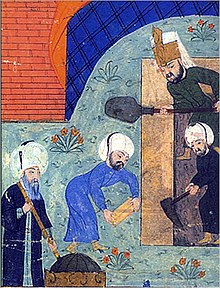
Back Mimar Sinan Afrikaans Sinan ALS ሚማር ሲናን Amharic Sinan AN معمار سنان Arabic معمار سنان ARZ Sinan AST Memar Sinan Azerbaijani معمار سینان AZB Синан Bashkir
This article needs additional citations for verification. (August 2021) |
Mimar Sinan | |
|---|---|
 Possibly Mimar Sinan (left) at the tomb of Suleiman the Magnificent, 1566 manuscript | |
| Born | c. 1488/1490 |
| Died | 17 July 1588 (aged 97–100) |
| Nationality | Ottoman |
| Occupation | Architect |
| Buildings | Süleymaniye Mosque Selimiye Mosque Mehmed Paša Sokolović Bridge Mihrimah Sultan Mosque Mihrimah Mosque Kılıç Ali Pasha Complex Şehzade Mosque Haseki Hürrem Sultan Baths Haseki Sultan Complex Sokollu Mehmet Pasha Mosque Rüstem Pasha Mosque Topkapi palace |
| Signature | |
 | |
Mimar Sinan (Ottoman Turkish: معمار سينان, romanized: Mi'mâr Sinân; Turkish: Mimar Sinan, pronounced [miːˈmaːɾ siˈnan]; c. 1488/1490 – 17 July 1588) also known as Koca Mi'mâr Sinân Âğâ, ("Sinan Agha the Grand Architect" or "Grand Sinan") was the chief Ottoman architect, engineer and mathematician for sultans Suleiman the Magnificent, Selim II and Murad III. He was responsible for the construction of more than 300 major structures, including the Selimiye Mosque in Edirne, the Kanuni Sultan Suleiman Bridge in Büyükçekmece, and the Mehmed Paša Sokolović Bridge in Višegrad, as well as other more modest projects such as madrasa's, külliyes, and bridges. His apprentices would later design the Sultan Ahmed Mosque in Istanbul and the Stari Most bridge in Mostar.
The son of a stonemason, he received a technical education and became a military engineer. He rose rapidly through the ranks to become first an officer and finally a Janissary commander, with the honorific title of Sinan.[1] He refined his architectural and engineering skills while on campaign with the Janissaries, becoming expert at constructing fortifications of all kinds, as well as military infrastructure projects, such as roads, bridges and aqueducts.[2] At about the age of fifty, he was appointed as chief royal architect, applying the technical skills he had acquired in the army to the "creation of fine religious buildings" and civic structures of all kinds.[2] He remained in this post for almost fifty years.
His masterpiece is the Selimiye Mosque in Edirne, although his most famous work is the Suleiman Mosque in Istanbul. He headed an extensive governmental department and trained many assistants who, in turn, distinguished themselves; these include Sedefkar Mehmed Agha, architect of the Sultan Ahmed Mosque and Mimar Hayruddin, architect of the Stari Most. He is considered the greatest architect of the classical period of Ottoman architecture and has been compared to Michelangelo, his contemporary in the West.[3][4] Michelangelo and his plans for St. Peter's Basilica in Rome were well known in Istanbul, since Leonardo da Vinci and he had been invited, in 1502 and 1505 respectively, by the Sublime Porte to submit plans for a bridge spanning the Golden Horn.[5] Mimar Sinan's works are among the most influential buildings in history.[6]
© MMXXIII Rich X Search. We shall prevail. All rights reserved. Rich X Search